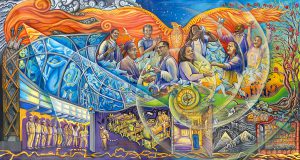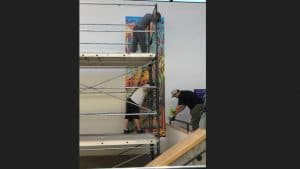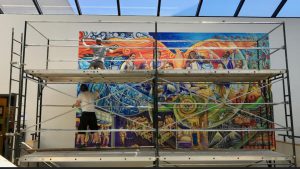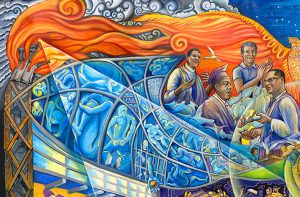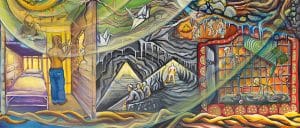Since all of the Estria Foundationʻs work is now currently in Hawai‘i, most of you do not know that we started out in Oakland, California and we are the financial sponsor of muralista maestra (mural master) Juana Alicia and her True Colors Mural Project. Juana and her team installed her latest mural titled “Incarceration to Liberation / De la Encarcelación a la Liberación” at San Francisco State University (SFSU) last month. Juana will speaking about feminism and public murals on Wednesday, July 25th, 2018 at the California Historical Society in San Francisco.
The Project Rebound Mural titled “From Incarceration to Liberation/ De la Encarcelación a la Liberación,” This mural was a student-driven collaboration between SFSU’s Project Rebound and the True Colors Mural Project of Berkeley City College.
Many voices have joined together to create the imagery to demand a new approach to crime and incarceration in our country, a country that differentiates itself from others by the staggering number of prisons and people behind bars or in custody awaiting trial. The design is the result of multiple conversations between members of Project Rebound, the SFSU community and the Berkeley City College Public Art Program’s Mural Design and Creation students, who worked together to give shape to the ideas expressed and shared by people who had firsthand knowledge and experience of life inside the prison industrial system.
The images in this mural represent the ideas of a growing movement against the unfair system of criminal justice. The design is an empowering expression of Project Rebound’s history that inspires and educates through the concepts of change and manifestation of one’s greatest potential through higher education.
Furthermore, the design serves to raise the consciousness of our communities by demystifying the negative stereotypes associated with those who are and have been incarcerated. Its overall messages are: prison abolition; the struggles and eventual triumph of the previously incarcerated; celebration of the human spirit and intellect in breaking through physical and intellectual barriers; and celebration of the visionary work of leaders in the prison abolition movement.
The muralʻs swirling design layout moves from imprisonment to liberation, in a left to right sequence, counter-clockwise.
The images in the mural “start in the upper left quadrant of the piece, where the prison guard tower, on fire, leans into the composition, billowing smoke across the top of the mural, leading our eyes toward the center of the composition. Beneath the smoke, in the center section of the drawing, human beings encased in and bound by their cells begin to move, break free, crawl, run and leap towards their liberation and the graduation celebration on the far right of the mural.
In the bottom third of the painting, there are various cells that represent a dystopic society. In the hyper-structured world of prison, the concept of time is referred to as “doing time”, and we represent this with a large, transparent clock overlaying the prison cell in the center. We observe the regimented, dulling and exploitive nature of life in prison: people chained together in their cellblock under the hardened watch of the guards, or in their bunks, writing letters and dreaming. Animals and griffin-like characters accompany them in the surreal dream world, where dollar bills drape their quarters, referring to the prison industrial complex, where inmates produce profits for a private economy.
As we move to the right, we see an individual in his cell, writing and then folding a letter into an origami bird, which flies out of the cell to transform into a real bird, and then into a multitude of birds taking flight. Moving to the right of the prison cell, we see a visual representation of Plato’s Allegory of the Cave, where figures debate about possible realities and forms of liberation. To the right of the cave, we see another representation of social imprisonment, where under the mesmerizing effect of a huge screen, people are forced to sell drugs, live in highly militarized communities, cross dangerous borders or work in alienating jobs in order to survive. We have also referred to the imagery of prison art, where the skeletons above them mock and laugh at the tragedy of this existence.
But there are signs of hope: the figures in the cave ascend the stairs into the light, a giant rosebush springs from the underground decay, and in the center of the composition, a phoenix rises to the sky above the graduation scene. Out of the multitudes of birds emerge the figures of graduates, role models and activists in the prison abolition movement. Among them are leaders such as Michelle Alexander, civil rights advocate and author of “The New Jim Crow: Mass Incarceration in the Age of Colorblindness,” John Irwin, founder of Project Rebound, Native American activist Leonard Peltier, and Rhodessa Jones, Director of the MEDEA Project for Incarcerated Women, who is also an actress and writer.
It is our hope that this mural will inspire the SFSU community to consider the importance of prison abolition, and to support the work of Project Rebound as it continues to turn convicts into scholars. We are proud to be able to contribute our creative work, and especially that of our students at Berkeley City College to San Francisco State University.”
– Juana Alicia and Tirso G. Araiza

